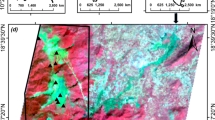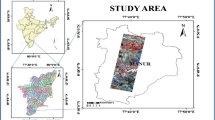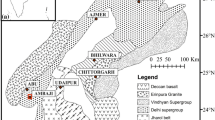Abstract
The prime contribution of this assignment was to examine the hyperspectral remote sensing, based on iron ore minerals identification using spectral angle mapper (SAM) technique. Correlation analyses between field iron contents and environmental variables (soil, water, and vegetation) have been performed. Spectral feature fitting (SFF) and multi-range spectral feature fitting (MRSFF) methods were used for accuracy assessment in extracting iron ore minerals from Hyperion EO-1 data. Spectral inspections as a reference were used in SAM technique for image classification for iron ore minerals: Hematite (24.26%), Goethite (32.98%) and Desert (42.76). Iron ore minerals classification is justified by the United States Geological Survey (USGS) spectral library and field sample points. The regression analysis of USGS and Hyperion reflectance spectra has shown the moderate positive correlation. The regression analyses between iron ore contents and environmental parameters (soil, water, and vegetation) have shown the moderate negative correlation. The examination was significantly effectual in extracting iron ore minerals: Hematite (SFF RMSE ≤ 0.51 MRSFF RMSE ≤ 0.48), Goethite (SFF RMSE ≤ 0.047 MRSFF RMSE ≤ 0.438) and Desert (SFF RMSE ≤ 0.63 and MRSFF RMSE ≤ 0.50); and the MRSFF RMSE histograms indicate the above result likened to a conventional SFF RMSE. MRSFF RMS error result is best because multiple absorption features typically characterize spectral signatures. This analysis demonstrates the potential applicability of the methodology for iron minerals identification framework and iron minerals impact on environmental parameters.










Similar content being viewed by others
References
Berk A, Bernstein LS, Anderson GP, Acharya PK, Robertson DC, Chetwynd JH, Adler-Golden SM (1998) MODTRAN cloud and multiple scattering upgrades with application to AVIRIS. Remote Sens Environ 65(3):367–375
Burns RG, Fisher DS (1990) Ironsulfur mineralogy of Mars: magmatic evolution and chemical weathering products. J Geophys Res Solid Earth 95(B9):14415–14421
Chang CI, Plaza A (2006) A fast iterative algorithm for implementation of pixel purity index. Geosci Remote Sens Lett IEEE 3(1):63–67
Clark RN (1999) Spectroscopy of rocks and minerals, and principles of spectroscopy. Man Remote Sens 3:3–58
Clark RN, Roush TL (1984) Reflectance spectroscopy: quantitative analysis techniques for remote sensing applications. J Geophys Res 89(B7):6329–6340
Clark RB, Zeto SK (2000) Mineral acquisition by arbuscular mycorrhizal plants. J plant Nutr 23(7):867–902
Clark RN, Gallagher AJ, Swayze GA (1990) Material absorption band depth mapping of imaging spectrometer data using the complete band shape leastsquares algorithm simultaneously fit to multiple spectral features from multiple materials. In: Proceedings of the third airborne visible/infrared imaging spectrometer (AVIRIS) workshop. JPL Publication pp 90–54, 176–186
Crowley JK, Brickey DW, Rowan LC (1989) Airborne imaging spectrometer data of the Ruby Mountains, Montana: mineral discrimination using relative absorption band-depth images. Remote Sens Environ 29(2):121–134
Datt B, McVicar TR, Van Niel TG, Jupp DL, Pearlman JS (2003) Preprocessing EO-1 Hyperion hyperspectral data to support the application of agricultural indexes. Geosci Remote Sens IEEE Trans 41(6):1246–1259
Debba P, Van Ruitenbeek FJA, Van Der Meer FD, Carranza EJM, Stein A (2005) Optimal field sampling for targeting minerals using hyperspectral data. Remote Sens Environ 99(4):373–386
Dehaan RL, Taylor GR (2002) Field-derived spectra of salinized soils and vegetation as indicators of irrigation-induced soil salinization. Remote Sens Environ 80(3):406–417
Dennison PE, Halligan KQ, Roberts DA (2004) A comparison of error metrics and constraints for multiple endmember spectral mixture analysis and spectral angle mapper. Remote Sens Environ 93(3):359–367
Gao BC, Montes MJ, Davis CO, Goetz AF (2009) Atmospheric correction algorithms for hyperspectral remote sensing data of land and ocean. Remote Sens Environ 113:S17–S24
Goetz AF, Srivastava VINAY (1985) Mineralogical mapping in the Cuprite mining district, Nevada. In: Proceedings of the airborne imaging spectrometer data analysis workshop, pp 22–29
Goodenough DG, Dyk A, Niemann KO, Pearlman JS, Chen H, Han T, West C (2003) Processing Hyperion and ALI for forest classification. Geosci Remote Sens IEEE Trans 41(6):1321–1331
Homer C, Huang C, Yang L, Wylie B, Coan M (2004) Development of a 2001 national land-cover database for the United States. Photogramm Eng Remote Sens 70(7):829–840
Horsnail RF (2001) Geochemical prospecting. https://doi.org/10.1036/1097-8542.285700
Hubbard BE, Crowley JK (2005) Mineral mapping on the Chilean–Bolivian Altiplano using co-orbital ALI, ASTER and Hyperion imagery: data dimensionality issues and solutions. Remote Sens Environ 99(1):173–186
Hunt GR, Ashley RP (1979) Spectra of altered rocks in the visible and near infrared. Econ Geol 74(7):1613–1629
Jarosik N, Bennett CL, Dunkley J, Gold B, Greason MR, Halpern M, Larson D (2011) Seven-year wilkinson microwave anisotropy probe (wmap wmap is the result of a partnership between Princeton University and NASA’s Goddard Space Flight Center. Scientific guidance is provided by the WMAP Science Team.) observations: sky maps, systematic errors, and basic results. Astrophys J Suppl Ser 192(2):14
Kayet N, Pathak K (2015) Remote sensing and GIS based land use/land cover change detection mapping in Saranda Forest, Jharkhand, India. Int Res J Earth Sci 3:1–6
Kayet N, Pathak K, Chakrabarty A, Sahoo S (2016a) Spatial impact of land use/land cover change on surface temperature distribution in Saranda Forest, Jharkhand. Model Earth Syst Environ 2(3):127
Kayet N, Pathak K, Chakrabarty A, Sahoo S (2016b) Urban heat island explored by co-relationship between land surface temperature versus multiple vegetation indices. Spat Inf Res 24(5):515–529
Kayet N, Pathak K, Chakrabarty A, Sahoo S (2017) Hyperspectral imaging techniques for iron minerals mapping in hilltop mining area. GEIM-2017 Geoinformatics for Environmental Issues and Management
Kayet N, Pathak K, Chakrabarty A, Sahoo S (2018) Evaluation of soil loss estimation using RUSLE model and SCS-CN method in hilltop mining areas. Int Soil Water Conserv Res 6(1):31–42
Kruse FA, Lefkoff AB, Dietz JB (1993) Expert system-based mineral mapping in northern Death Valley, California/Nevada, using the airborne visible/infrared imaging spectrometer (AVIRIS). Remote Sens Environ 44(2–3):309–336
Kumar D, Rao DS, Sridhar K, Satyanarayanan M, Patro PK (2016) Integrated geophysical and geological studies for mineral prospecting in Betul-Chhindwara belt (BCB), Central India. J Geol Soc India 87(4):383–396
Lantzy RJ, Mackenzie FT (1979) Atmospheric trace metals: global cycles and assessment of man’s impact. Geochim Cosmochim Acta 43(4):511–525
Lee HY, Chung IH, Seok W, Kang HS, Lee HS, Ko JS, Park SS (1992) Variations of the ventral rami of the brachial plexus. J Korean Med Sci 7(1):19–24
Magendran T, Sanjeevi S (2014) Hyperion image analysis and linear spectral unmixing to evaluate the grades of iron ore in parts of Noamundi, Eastern India. Int J Appl Earth Obs Geoinf 26:413–426
Mange MA, Maurer H (2012) Heavy minerals in colour. Springer, Netherlands
Molan YE, Refahi D, Tarashti AH (2014) Mineral mapping in the Maherabad area, eastern Iran, using the HyMap remote sensing data. Int J Appl Earth Obs Geoinf 27:117–127
Mundt JT, Glenn NF, Weber KT, Prather TS, Lass LW, Pettingill J (2005) Discrimination of hoary cress and determination of its detection limits via hyperspectral image processing and accuracy assessment techniques. Remote Sens Environ 96(3):509–517
Nefeslioglu HA, San BT, Gokceoglu C, Duman TY (2012) An assessment on the use of Terra ASTER L3A data in landslide susceptibility mapping. Int J Appl Earth Obs Geoinf 14(1):40–60
Pan Z, Huang J, Wang F (2013) Multi range spectral feature fitting for hyperspectral imagery in extracting oilseed rape planting area. Int J Appl Earth Obs Geoinf 25:21–29
Raj SK, Ahmed SA, Srivatsav SK, Gupta PK (2015) Iron oxides mapping from E0-1 Hyperion data. J Geol Soc India 86(6):717–725
Rasel SM, Chang HC, Ralph T, Saintilan N (2015) Endmember identification from EO-1 Hyperion L1_R Hyperspectral data to build saltmarsh spectral library in Hunter Wetland, NSW, Australia. In: SPIE remote sensing. International Society for Optics and Photonics, pp 96371O–96371O
Reddy KR, Kakanl VG, Zhao D, Kotl S, Gao W (2004) Interactive effects of ultraviolet-B radiation and temperature on cotton physiology, growth, development and hyperspectral reflectance. Photochem Photobiol 79(5):416–427
Sahoo S, Dhar A, Kayet N, Kar A (2017) Detecting water stress scenario by land use/land cover changes in an agricultural command area. Spat Inf Res 25(1):11–21
Vaish J, Pal SK (2015) Subsurface coal fire mapping using magnetic survey at East Basuria Colliery, Jharkhand. J Geol Soc India 86(4):438–444
Van der Meer F (2006) The effectiveness of spectral similarity measures for the analysis of hyperspectral imagery. Int J Appl Earth Obs Geoinf 8(1):3–17
Williams AP, Hunt ER (2002) Estimation of leafy spurge cover from hyperspectral imagery using mixture tuned matched filtering. Remote Sens Environ 82(2):446–456
Xu J, Kang SC, Saito K, Zhao HT (2011) U.S. Patent No. 7,974,039. U.S. Patent and Trademark Office, Washington
Author information
Authors and Affiliations
Corresponding author
Rights and permissions
About this article
Cite this article
Kayet, N., Pathak, K., Chakrabarty, A. et al. Mapping the distribution of iron ore minerals and spatial correlation with environmental variables in hilltop mining areas. Environ Earth Sci 77, 308 (2018). https://doi.org/10.1007/s12665-018-7482-7
Received:
Accepted:
Published:
DOI: https://doi.org/10.1007/s12665-018-7482-7




